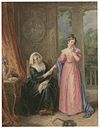Alazon

Alazṓn(Ancient Greek:ἀλαζών) is one of threestock charactersincomedyof thetheatre of ancient Greece.[1]He is the opponent of theeirôn.Thealazṓnis animpostorthat sees himself as greater than he actually is. Thesenex iratus(the angry father) and themiles gloriosus(the braggart soldier) are two types ofalazṓn.[2]
Miles Gloriosus
[edit]Miles Gloriosus(literally, "braggart-soldier", inLatin) is astock characterof a boastful soldier from thecomictheatre of ancient Rome,and variations on this character have appeared indramaandfictionever since.[3]The character derives from thealazṓnor "braggart" of theGreek Old Comedy(e.g.Aristophanes). The term "Miles Gloriosus" is occasionally applied in a contemporary context to refer to a posturing and self-deceiving boaster or bully.
Literary instances
[edit]In the playMiles Gloriosus( "Boastful Soldier" ) byPlautus,the term applies to the main character Pyrgopolynices. This foolishMiles Gloriosusbrags openly and often about his supposed greatness, while the rest of the characters feign their admiration and secretly plot against him. Heavily borrowing from Plautus, theStephen Sondheim-Burt Shevelove-Larry GelbartmusicalA Funny Thing Happened on the Way to the Forumfeatures a warrior named Miles Gloriosus.
An example inTerenceof thealazoncharacter is Thraso in theEunuchus.Like Pyrgopolinices in theMiles Gloriosus,Thraso is attended by a flatterer or parasite who follows him round and attends to his wishes. Like Pyrgopolinices, Thraso is wealthy and is a rival of the young man in the story for the love of a courtesan.
Shakespeareuses the type most notably with the bombastic and self-glorifying ensignAncient PistolinHenry IV, Part 2,The Merry Wives of WindsorandHenry V.[4]Other examples are "fashion's own knight", the Spaniard Armardo, inLove's Labour's Lost,the worthless Captain Parolles inAll's Well That Ends Well,andFalstaffinHenry IV, Part 1andPart 2,andThe Merry Wives of Windsor.Sir Tophas ofJohn Lyly'sEndymionalso fits the mold.
Baron Munchausenis a braggart soldier.
InCommedia dell'arte,the figure ofIl Capitanois amiles gloriosus.[5]
In the novel,A Confederacy of Dunces,the main character, Ignatius J. Reilly, believes himself to be better than everyone because of his apathy towards modern society and his Medievalist views.
Other media
[edit]In music, the title role ofHáry JánosbyKodályis an example of the character.
In the PC gameThe Elder Scrolls III: Morrowind,there is a non-playable character named Miles Gloriosus, willing to brag about his accomplishments as soldier.
Senex iratus
[edit]Thesenex iratusor heavy father figure is a comicarchetypecharacter who belongs to the alazon or impostor group intheater,manifesting himself through his rages and threats, his obsessions and his gullibility.
His usual function is to impede the love of thehero and heroine,and his power to do so stems from his greater social position and his increased control of cash. In theNew Comedy,he was often the father of the hero and so his rival. More frequently since, he has been the father of the heroine who insists on her union with the bad fiancé; as such, he appears in bothA Midsummer Night's Dream,where he fails and so the play is a comedy, andRomeo and Juliet,where his acts are successful enough to render the play a tragedy.
PantaloneinCommedia dell'arteacts as asenex iratus.
In hisAnatomy of Criticism,Northrop Fryeconsidered all blocking humors in comedy to be variations on the basic function of thesenex iratus.
See also
[edit]References
[edit]- ^Carlson (1993, 23) and Janko (1987, 45, 170).
- ^Frye, Northrop (1973) [1957]. "First Essay: Historical Criticism".Anatomy of Criticism: Four Essays.Princeton University Press. p. 39.ISBN0-691-01298-9.
alazon,which means imposter, someone who pretends or tries to be something more than he is. The most popular types ofalazonare themiles gloriosusand the learned crank or obsessed philosopher.
- ^Frye, Northrop. 1957.Anatomy of Criticism: Four Essays.London: Penguin, 1990.ISBN0-14-012480-2.
- ^Victor L. Cahn, Shakespeare the Playwright: A Companion to the Complete Tragedies, Histories, Comedies, and Romances, Praeger, Westport, 1996. p.468.
- ^John Rudlin,Commedia dell'Arte: An Actor's Handbook,p. 120,ISBN0-415-04770-6.
Further reading
[edit]- Carlson, Marvin. 1993.Theories of the Theatre: A Historical and Critical Survey from the Greeks to the Present.Expanded. Ithaca and London: Cornell University Press.ISBN978-0-8014-8154-3.
- Janko, Richard, trans. 1987.Poetics with Tractatus Coislinianus, Reconstruction of Poetics II and the Fragments of the On Poets.ByAristotle.Cambridge: Hackett.ISBN0-87220-033-7.
External links
[edit]- Character FunctionsArchived2009-03-18 at theWayback Machine

